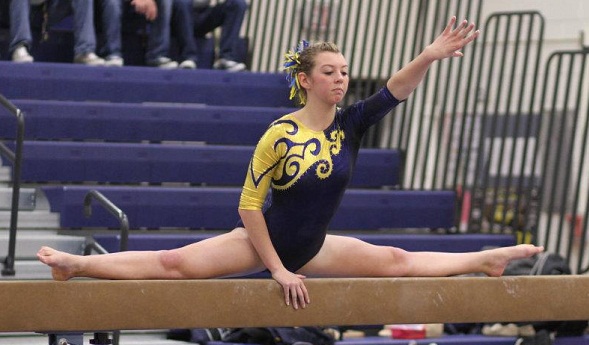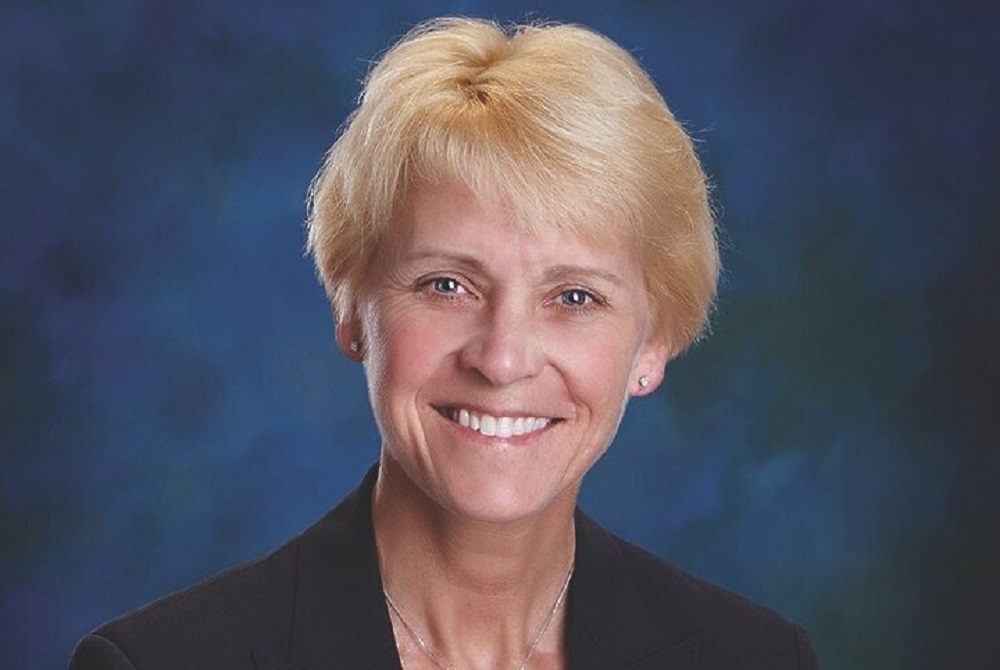
Grand Ledge Gymnastics: Drive for 5
February 2, 2012
GRAND LEDGE – Christine Wilson remembers losing. It’s something of a distant memory, but sticks with the Grand Ledge gymnastics team’s senior captain to this day.
“When I was a club gymnast, back when I was younger, I was never really good. So it’s not like I didn’t know how to lose,” Wilson said. “I’ve struggled unbelievably. But in high school, I just grew a lot. We’ve won every meet, and I’d like to keep it up.”
Nope, that’s not a typo or misquote. The Comets have won 68 straight meets, be they duals or multi-team events, including the last four MHSAA Finals. And with a line-up young but full of experience, they’re hoping to extend that streak through March 9, the date of this season’s MHSAA Team Final at Grand Rapids Kenowa Hills.
Only Ludington (1975-79) has won five straight MHSAA titles, and the final one of that run was shared. Grand Ledge and Holland (1994-97) both have won four straight over the history of the tournament.
The Comets will find out Saturday how they might stack up as contenders this March. After facing many of the Grand Rapids area’s top teams in winning last weekend’s Grand Rapids Kenowa Hills Invitational, Grand Ledge will head to the Canton Invitational for what lately has been the most competitive regular-season gymnastics meet in the state.
The Comets remain tough to beat, despite Wilson being the only senior in the starting line-up the team used Wednesday in a Capital Area Activities Conference win over Haslett/Williamston/Bath, another returning MHSAA Finalist from a year ago.
Granted, Wilson might be as valuable a leader as any team in Michigan can claim. She’s the reigning MHSAA Division 2 individual champion, and this season is competing in Division 1 with the aspiration of becoming – Comets coach Duane Haring believes – the first gymnast to win both Division 2 and then Division 1 individual titles.
But she’s also just one of four on her team who have posted all-around scores of at least 37.35 this winter. Sophomore Presley Allison and juniors Lauren Clark and Sara Peltier all have done the same after finishing third, eighth and 12th all-around at last season’s Division 2 Final.
A number of others also are contributing, led by sophomore Taylor Stevens and freshman Hailey French, who both have posted all-around scores pushing 34.
It’s something of the same old story for the team under the guidance of Haring, who after much cajoling from his gymnast daughter Allison and her teammates took over the program in 2002. They told him at the time that no one at Grand Ledge knew the gymnastics team existed, down to not having a trophy case of its own.
He led the Comets to their first MHSAA Team Final that season, and the team has been filling a new trophy case for a decade. He stepped away to work as an assistant coach at Michigan State from 2005-06, but returned for 2006-07 and that season brought Grand Ledge to within 1.625 points of its first MHSAA championship before the Comets started the incredible winning streak the next winter.
Haring meets with his team before the season in a room at the school, or sometimes they just sit in a hallway. He starts with, “We’ll, we’ve been pretty successful the last couple of years. Wherever you want to go this year is up to you.” If they want to do just a little gymnastics and have merely a decent season, he’s fine with that and will coach them to that level. But if they want to pursue another championship, it’s going to be tough and so will his coaching style.
They’ve always responded that they want to be the best they can.
“A couple of times the last couple of years, when we were dragging, I’d say, ‘Ladies, at the beginning of the year I asked you where you wanted to go, what your goals are. There’s no turning back now,’” Haring said. “I let them set the expectations. They’re not set by me.”
Expectations are high, but so is support. Former Comets’ standout Kelli Maxwell continues as an assistant, and a number of Grand Ledge gymnasts past are regulars helping out with other tasks or just cheering the team on.
The pressure is high too. No one wants to be on the team that breaks the streak. But so far that’s been more of a motivator than distraction.
“It’s really hard especially when you’re the only senior captain, going for the state title, and undefeated,” Wilson said. “If you’re that person who has a loss or who falls at the state competition, it’s a big burden.
“(But) I love all of it.”
PHOTOS courtesy of the Grand Ledge gymnastics program.
TOP: Comets junior Lauren Clark finished eighth at last season's Division 2 Individual Final and is among Grand Ledge's most experienced contributors this winter.
BELOW: Senior Christine Wilson is the reigning Division 2 individual champion and hopes to claim the Division 1 title next month.

Title IX Continues to Fuel Growth of Girls and Women’s Sports, Olympic Dominance
By
Karissa Niehoff
NFHS Executive Director
September 24, 2021
To say that American female athletes dominated the recent Olympics in Tokyo would be an understatement.
Among the 66 medals earned by American female Olympians – most by any country in the history of the Games – were gold-medal performances by the U.S. basketball, volleyball, water polo and beach volleyball teams. Eighteen medals were earned by the U.S. women swimmers, female track and field athletes claimed 15 medals, and the U.S. women’s softball and soccer teams won silver and bronze medals, respectively.
In the past 30 years of the Olympic Games, the United States has dominated the women’s team sports of basketball (nine golds), soccer (four golds, one silver, one bronze) and softball (three golds, two silvers) — not to mention the untold number of medals in track and field. And this past summer, the U.S. women’s volleyball team claimed its first gold medal.
These performances by some of our nation’s most skilled female athletes never would have been possible without the passage of Title IX and the offerings of these sports through our nation’s schools. With the chance to play afforded by the landmark Title IX legislation in 1972, girls participation in several high school sports skyrocketed in the years that followed.
When the NFHS conducted its first participation survey in 1971, basketball and outdoor track and field were the primary girls sports, comprising about two-thirds of the 294,000 total. However, with the opportunity to play additional sports, girls flocked to volleyball and softball first, along with cross country and eventually soccer.
Soccer, in fact, has had the most remarkable growth. In 1971, only 700 girls were playing high school soccer. Twenty-five years later, that number had climbed to almost 210,000; and as the 50th anniversary of Title IX approaches, there are now almost 400,000 girls playing high school soccer – a staggering 56,200 percentage increase in 50 years. Soccer now ranks fourth in popularity among girls high school sports – all because of that opportunity in 1972.
There are many other success stories, however. The pre-Title IX survey in 1971 indicated that 1,719 girls were participating in cross country. With increases every year until 2015, today, there are 219,345 girls competing in high school programs and the sport ranks sixth in popularity.
Although participation numbers have leveled a bit the past 10 years, fast-pitch softball is another sport that flourished after the passage of Title IX. With fewer than 10,000 participants in 1971, the numbers quickly rose to 220,000 by 1985 and 343,000 by 2000, and softball is currently fifth among girls sports with 362,038 participants.
Since track and field and basketball were the primary sports in the early days of girls sports programs, increases in those sports have not been as dramatic; however, they remain the first and third most-popular sports, respectively, today. Volleyball, however, much like soccer, continues its upward climb.
Without a doubt, volleyball has seen the steadiest increases among girls high school sports the past 50 years. After starting with 17,952 participants in 1971, the numbers jumped to 300,810 by 1990 and 409,332 by 2010 and 452,808 by 2018. During its climb, volleyball surpassed basketball as the No. 2 girls sport.
And among the top six girls sports from 2010 to 2018 (numbers are not available the past two years due to the pandemic), volleyball has gained the most participants (43,476), followed by soccer (32,549). And all of this has occurred thanks to legislation passed in 1972 that was not fundamentally meant to address opportunities for girls to participate in high school sports.
The NFHS is leading a yearlong celebration of the 50th anniversary of Title IX, which officially occurs on June 23, 2022. “Title IX at 50 – Celebrating and Growing Opportunities” is highlighting the law’s impact by celebrating the inspirational individuals and landmark moments in the history of Title IX, and continuing to grow the educational and competitive opportunities for the future.
More information, including a Title IX Timeline, Title IX Milestones, The History and Importance of Title IX, Title IX Fact Sheet, Title IX Frequently Asked Questions and several Title IX videos, can be accessed on the NFHS Website.
Dr. Karissa L. Niehoff is beginning her fourth year as executive director of the National Federation of State High School Associations (NFHS) in Indianapolis. She is the first female to head the national leadership organization for high school athletics and performing arts activities and the sixth full-time executive director of the NFHS. She previously was executive director of the Connecticut Association of Schools-Connecticut Interscholastic Athletic Conference for seven years.

